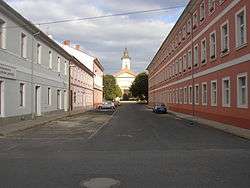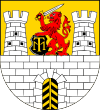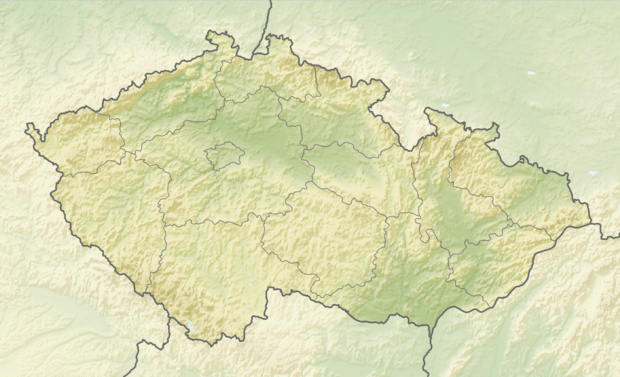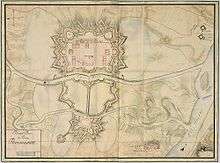Terezín
Terezín (Czech pronunciation: [ˈtɛrɛziːn] (![]()
Terezín Theresienstadt | |
|---|---|
Town | |
 View to the Church of the Resurrection of Christ from Havlíček Street | |
 Flag  Coat of arms | |
| Etymology: named after Empress Maria Theresa | |
 Terezín Location in the Czech Republic | |
| Coordinates: 50°30′40″N 14°9′2″E | |
| Country | |
| Region | Ústí nad Labem |
| District | Litoměřice |
| Founded | 1780 |
| Government | |
| • Mayor | René Tomášek |
| Area | |
| • Total | 13.52 km2 (5.22 sq mi) |
| Elevation | 150 m (490 ft) |
| Population (2020-01-01[1]) | |
| • Total | 2,899 |
| • Density | 210/km2 (560/sq mi) |
| Time zone | UTC+1 (CET) |
| • Summer (DST) | UTC+2 (CEST) |
| Postal code | 411 55 |
| Website | www |
Geography
The town is located in North Bohemia, along the Ohře River, near its confluence with the Elbe River at Litoměřice.
History
On 10 January 1780, the Habsburg emperor Joseph II ordered the erection of the fortress, named Theresienstadt after his mother Empress Maria Theresa. In the times of Austria–Prussia rivalry, it was meant to secure the bridges across the Ohře and Elbe Rivers against Prussian troops invading the Bohemian lands from neighbouring Saxony. Simultaneously, Josefov Fortress (Josephstadt) was erected near Jaroměř as a protection against Prussian attacks.

Construction of Theresienstadt started at the westernmost cavalier on 10 October 1780 and lasted ten years. The fortress consisted of a citadel, the "Small Fortress" (Kleine Festung), to the east of the Ohře, and a walled town, the "Main Fortress" (Große Festung), to the west. The total area of the fortress was 3.89 km². In peacetime it held 5,655 soldiers, and in wartime around 11,000 soldiers could be placed here. Trenches and low-lying areas around the fortress could be flooded for defensive purposes. Garrison church in the Main Fortress was designed by Heinrich Hatzinger, Julius D’Andreis and Franz Joseph Fohmann.[2]
The fortress was never under direct siege. During the Austro-Prussian War, on 28 July 1866, part of the garrison attacked and destroyed an important railway bridge near Neratovice (rail line Turnov – Kralupy nad Vltavou) that was shortly before repaired by the Prussians.[3] This attack occurred two days after Austria and Prussia had agreed to make peace, but the Theresienstadt garrison was ignorant of the news.[4]
During the second half of the 19th century, the fortress was also used as a prison. During World War I, the fortress was used as a political prison camp. Many thousand supporters of Russia (Ukrainian Russophiles from Galicia and Bukovina) were placed by Austro-Hungarian authorities in the fortress. Gavrilo Princip, who assassinated Franz Ferdinand, Archduke of Austria and his wife, died there of tuberculosis in 1918.
With the collapse of the Austro-Hungarian Empire in 1918, the town became part of the newly formed state of Czechoslovakia. It was located in an area with a high proportion of ethnic German population, known as the Sudetenland. Nazi Germany used this population of ethnic Germans as a rationale for expansion of the borders of the Fatherland. In 1938 it annexed the Sudetenland. It then followed in 1939 by occupying the rest of Bohemia and Moravia part of Czechoslovakia.
Terezín during World War II
Theresienstadt concentration camp
After the Munich Agreement in September 1938 and following the occupation of the Czech lands in March 1939, with the existing prisons gradually filled up as a result of the Nazi terror, the Prague Gestapo Police prison was set up in the Small Fortress (see History) in 1940. The first inmates arrived on 14 June 1940. By the end of the war 32,000 prisoners of whom 5,000 were women passed through the Small Fortress. These were primarily Czechs, later other nationals, for instance citizens of the former Soviet Union, Poles, Germans, and Yugoslavs. Most of the prisoners were arrested for various acts of resistance to the Nazi regime; among them were the family members and supporters of the assassins of Reinhard Heydrich. Many prisoners were later sent to concentration camps such as Mauthausen. The Jewish Ghetto was created in 1941.
By 1940, Germany assigned the Gestapo to adapt Terezín, better known by the German name Theresienstadt, as a ghetto and concentration camp. Considerable work was done in the next two years to adapt the complex for the dense overcrowding that inmates would be subjected to. It held primarily Jews from Czechoslovakia, as well as tens of thousands of Jews deported chiefly from Germany and Austria, as well as hundreds from the Netherlands and Denmark. More than 150,000 Jews were sent there, including 15,000 children.[5]
Although it was not an extermination camp, about 33,000 died in the ghetto. This was mostly due to the appalling conditions arising out of extreme population density, malnutrition and disease. About 88,000 inhabitants were deported to Auschwitz and the other extermination camps.[5][6] As late as the end of 1944, the Germans were still deporting Jews to the death camps. At the end of the war, there were 17,247 survivors of Theresienstadt (including some who had survived the death camps).[5]
Part of the fortification (Small Fortress) served as the largest Gestapo prison in the Protectorate of Bohemia and Moravia. It was on the other side of the river from the ghetto and operated separately. Around 90,000 people went through it, and 2,600 died there.[5]
The complex was taken over for operation by the International Red Cross on 2 May 1945, with the Commandant and SS guards fleeing within the next two days. Some were later captured. The camp and prison were liberated on 9 May 1945 by the Soviet Army.[5]
Terezín after World War II
After the German surrender the small fortress was used as an internment camp for ethnic Germans. The first prisoners arrived on 10 May 1945. On 29 February 1948 the last German prisoners were released and the camp was officially closed.
Among the interned Germans were former Nazis like Heinrich Jöckel, the former commander of Terezín and other SS members. A great group of internees was arrested because of their German nationality, among them young boys and elderly people.
In the first phase of the camp lasting until July 1945 mortality was high due to diseases, malnutrition and incidents of simple outright murder. Commander of the camp in that period was Stanislav Franc. He was guided by a spirit of revenge and tolerated whimsical mistreatment of the prisoners by the guards.
In July 1945 the camp shifted under the control of the Czech ministry for domestic affairs. The new commander appointed was Otakar Kálal. From then on the inmates were gradually transferred to Germany and Terezín was increasingly used as a hub for the forced migration of Germans from the Czech lands into Germany proper.
Terezín today
After the related war uses, such as for holding ethnic Germans to be expelled, the government retained a military garrison until 1996. The troops' departure and closing down of related operations had a negative effect on the local economy of the small town.
Terezín is still trying to develop a more diverse economy; some people think its history can attract heritage tourism. In 2002, the fortress, which was in a deteriorated condition, was listed in the 2002 World Monuments Watch by the World Monuments Fund.[7] The organization called for a comprehensive conservation plan, while providing funding for emergency repairs from American Express. In 2002 the town was struck by floods during which the crematorium was damaged.[8] A conservation plan was eventually developed in cooperation with national authorities. According to the Fund, a long-term conservation plan was conceived, which includes further repairs, documentation, and archaeological research.[7]
In mid-April 2008, 327 bronze grave markers were stolen from the Jewish cemetery; another 700 were stolen the following week. The high price of metal encouraged the vandalizing thieves. Some grave markers were recovered.[9]
Economy
Terezín is noted for its production of furniture and knitwear, as well as for manufacturing.
Notable people
- Alexander Ypsilantis (1792–1828), leader of the Greek revolution of 1821
- Pauline Metzler-Löwy (1853–1921), Austrian contralto singer
- Gavrilo Princip (1894–1918), assassin of Franz Ferdinand
- Zuzana Růžičková (1927–2017), harpsichordist
Twin towns – sister cities



Representation in other media
- I Never Saw Another Butterfly (1994), a collection of works of art and poetry by Jewish children who lived in the concentration camp Theresienstadt. This book is named after a 1942 poem by Pavel Friedmann (born 1921) who was incarcerated at Theresienstadt and was later killed at Auschwitz. Where known, the fate of each young author is listed.
- In Austerlitz (2001) by W. G. Sebald the eponymous character's mother is deported to the ghetto in Terezín, before being later sent east, where she perished at another camp.
- And A Child Shall Lead (2005), a play by American writer Michael Slade, takes place in Terezín concentration camp during World War II, specifically 1942–1945. The play revolves around eight Jewish children, from ages six to fifteen, who create a secret newspaper to tell the world what is happening behind the camp's walls.[11]
- In The Lost Wife (2011), a novel by Alyson Richman, one of the main characters, Lenka, is transported to Terezín concentration camp during World War II.
- Czech novelist Ivan Klíma describes his childhood time in the Terezín ghetto in his autobiography, My Crazy Century (2013).
- Born Survivors (2015) a novel by Wendy Holden tells of three young mothers and their extraordinary story of courage, defiance and hope.[12]
Gallery
- The cell where Gavrilo Princip was kept
 Town church
Town church.jpg)
- One of the child drawings from Terezín, now exhibited in the Pinkas Synagogue
References
- "Population of Municipalities – 1 January 2020". Czech Statistical Office. 2020-04-30.
- Damjanovic, Dragan. "The Hatzinger Family of Builders – From Székesfehérvár, through Osijek, Lviv, and Zadar to Vienna, in: Acta Historiae Artium, Budapest, 57 (2016) ; 167-186". Acta Historiae Artium.
- Description of the attack, pictures of the destroyed bridge: Světozor, September 20, 1867 UCL.cas.cz
- Wagner, Arthur L. (Lt.Col., U.S. Army). The Campaign of Königgrätz, Second Edition, 1899 p. 108
- "Theresienstadt Camp", Holocaust Encyclopedia, United States Holocaust Memorial Museum, (accessed May 7, 2007).
- Theresienstädter Studien und Dokumente (accessed October 5, 2007).
- World Monuments Fund - Terezín Fortress
- Terezin.cz
- Patricia Treble (2008). "Meltdown: metal prices spur thieves". Maclean's Magazine: 35.
- "Partnerská města" (in Czech). Město Terezín. Retrieved 2020-08-17.
- Michael Slade, And a Child Shall Lead: Production History, Playscripts website, accessed 22 May 2013
- Shaffi, Sarah (April 8, 2014). "Sphere buys Holocaust survivors' story". The Bookseller. Retrieved March 8, 2019.
External links
| Wikimedia Commons has media related to Terezín. |
| Wikivoyage has a travel guide for Terezín. |